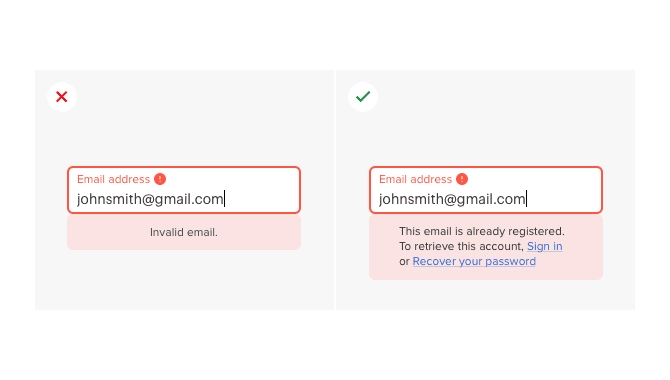Top 8 Things which Most UI/UX Designers Ignore in 2025
Written by UIDesignz Aug 3, 2023 4 min read
Last updated: Dec 30 2024

In the fast-changing world of UI/UX design, making great user experiences needs both creativity and precision. But sometimes, designers miss important things that can really affect their work. This guide shares 8 things they often miss and common mistakes which should be avoided.
This comprehensive guide sheds light on commonly overlooked factors and reveals common mistakes, aiming to empower designers to create more intuitive, engaging, and satisfying experiences for users.The goal is to help designers make designs perfect and avoid mistakes which are also avoided by designers of our UI UX design agency.
Table of Contents
Accessibility for All
Accessibility for all ensures digital content and spaces are designed to accommodate diverse needs, providing an inclusive experience. It prioritises usability for people with disabilities, fostering equal access and engagement. Creating universally accessible environments promotes a more equitable and user-friendly online world.
- Importance of inclusive design for users with disabilities.
- Consideration of screen readers, keyboard navigation, color contrast, and text size.
- Making accessibility a fundamental part of the design process.

Accessibility for All (image by Medium)
Performance Optimization
Performance optimization involves enhancing the efficiency and speed of a system or website to ensure optimal functionality. It aims to streamline processes, reduce loading times, and enhance great user experience, contributing to a smooth and high-performing digital environment.
- Recognition of the role of performance in user satisfaction.
- Strategies for optimising speed and responsiveness.
- Focus on image optimization, efficient coding, and caching mechanisms.
Cross-Platform Consistency
Cross-platform consistency ensures uniformity in design and functionality across various devices and operating systems. It aims to deliver a smooth and cohesive user experience, regardless of whether users access content on a desktop, tablet, or mobile device. This approach increases reliability and user satisfaction in diverse digital environments.
- Acknowledging the diversity of devices and screen sizes.
- Prioritising responsive design principles and consistent branding.
- Ensuring a seamless user experience across various platforms.

Cross Platform Consistency (image by Medium)
Micro-interactions and Feedback
Micro-interactions and feedback are subtle design elements that provide users with responsive and intuitive experiences. These small, purposeful animations or responses enhance user engagement by offering visual cues and acknowledging their actions. In professional UI UX design services, these thoughtful details contribute to a more user-friendly and interactive interface.
- Recognition of the impact of micro-interactions on user engagement.
- Importance of clear and informative feedback for user empowerment.
- Enhancing usability and emotional connection through subtle design elements.
User Flow
User flow is the step-by-step journey a user takes through a website design or application to achieve a specific goal. It focuses on creating a logical and intuitive path, guiding users smoothly from one interaction to the next. A well-designed user flow enhances usability and ensures a positive overall experience.
- Avoiding the oversight of the overall user flow in the design.
- Embracing information architecture for organised content presentation.
- Creating a well-structured and intuitive navigation experience.

User-Flow (image by Medium)
Slow Internet Connections
Slow internet connections refer to reduced data transfer speeds, causing delays in loading web pages or streaming content. These connectivity issues can result from various factors, impacting the user's online experience by affecting download and upload speeds. Addressing and troubleshooting these issues are essential for a smoother and more efficient internet usage.
- Acknowledging the global diversity in internet speeds and devices.
- Prioritising optimization for slower connections through data compression and progressive loading.
- Fostering inclusivity in design for users with limited connectivity.
Read More: 10 UX Prototyping Tools for UI UX Designers.
Error Handling and Messaging
Error handling and messaging involve the design and implementation of a system's response to unexpected events or user mistakes. This crucial aspect ensures clear and informative messages guide users through errors, helping them understand and resolve issues seamlessly. A well-crafted error handling system enhances user experience by minimising confusion and frustration.
- Emphasising the importance of thoughtful error handling.
- Clear and actionable error messages to prevent user frustration.
- Incorporating user feedback loops for continuous improvement.

Error Handling and Messaging (image by Medium)
User Testing
User testing involves gathering feedback from real users to evaluate the usability and effectiveness of a product or design system. Through controlled scenarios, it identifies areas for improvement, ensuring a user-centric design. This iterative process is essential for refining and optimising the user experience.
- Highlighting the significance of testing designs with real users.
- Gaining valuable insights to improve the user experience.
- Ensuring user-centric practices for higher satisfaction and brand loyalty.
Conclusion
Paying attention to accessibility, performance, consistency, user interactions, and testing is key for great design. These details make websites and apps work well for everyone. By avoiding common mistakes and embracing these principles, designers create smoother, more enjoyable experiences for users, raising the bar for design excellence.





